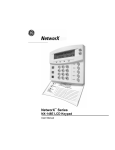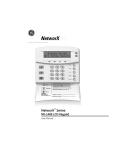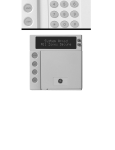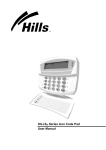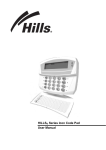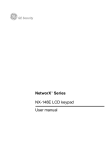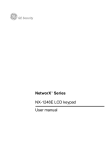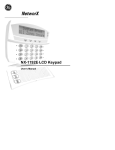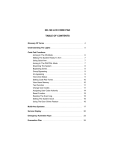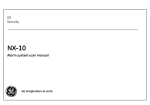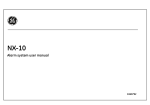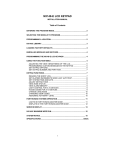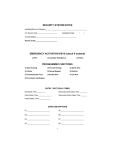Download HILLS Series LCD Code Pad User Manual
Transcript
HILLS® Series LCD Code Pad User Manual THIS MANUAL IS FURNISHED TO HELP YOU UNDERSTAND YOUR SECURITY SYSTEM AND BECOME PROFICIENT IN ITS OPERATION. ALL USERS OF YOUR SECURITY SYSTEM SHOULD READ AND FOLLOW THE INSTRUCTIONS AND PRECAUTIONS IN THIS BOOKLET BEFORE OPERATING YOUR SECURITY CONTROL SYSTEM. FAILURE TO DO SO COULD RESULT IN THE SECURITY SYSTEM NOT WORKING PROPERLY. THIS BOOKLET SHOULD BE KEPT IN AN ACCESSIBLE LOCATION FOR THE LIFE OF THE SECURITY SYSTEM. IF YOU DO NOT UNDERSTAND ANY PART OF THIS MANUAL, YOU SHOULD NOTIFY YOUR INSTALLING COMPANY. READ THE ENTIRE MANUAL AND, IF POSSIBLE, PRACTICE ON THE KEYPAD CONTROL WHILE YOUR PROFESSIONAL INSTALLER IS ON SITE. The SECURITY CONTROL can be turned on (ARMED) and off (DISARMED) by entering a 4 or 6 digit code into the Keypad Control, which is similar to a telephone keypad. If your Security Control has been so programmed, you may be able to turn on (ARM) your System by simply pressing the [STAY] or [EXIT] key. The system must always be Disarmed using a 4 or 6 digit code. The LCD keypad includes 9 lights and a 32-character liquid crystal display and a built-in electronic sounder. These provide specific information relating to the status of the security system which is described in the booklet. Understanding what the lights and sounds mean will help you to easily operate your system. KEEP IN MIND, THE LEVEL OF SECURITY YOU WILL OBTAIN WITH THIS SYSTEM RELATES SPECIFICALLY WITH TWO MAJOR FACTORS: 1. The quantity, quality, and placement of security devices attached to this system. 2. The knowledge you have of the security system and how that knowledge is utilized in a weekly test of the complete system. YOU SHOULD BE AWARE OF THE FOLLOWING FACTS WHEN PREPARING A SAFETY/SECURITY PLAN FOR YOUR HOME/BUSINESS. 1. Your security system is an electronic device and like any electronic device is subject to failure or malfunction. Do not rely on it as your single source of security. 2. Your system should be tested weekly. 3. Your system will not work without power. 4. Warning devices will need to be loud enough, wired correctly, and properly placed to provide notification of an alarm event. 5. Smoke and heat detectors may not detect heat and smoke in all situations. 6. Use qualified security professionals to install and maintain your security system. 7. It may be possible to arm the security system without the backup battery connected. Your periodic test should be done with A.C. power removed to verify the battery is connected and adequately charged. 8. Care should be taken to plug in and restrain the A.C. Transformer after testing. This product is to be installed by qualified SERVICE PERSONNEL only The equipment should only be operated with an approved power adapter with insulated live pins. CAUTION – RISK OF EXPLOSION IF BATTERY IS REPLACED BY AN INCORRECT TYPE. DISPOSE OF BATTERIES ACCORDING TO THE INSTRUCTIONS. CONTACT YOUR INSTALLER FOR REPLACEMENT BATTERIES. When installed as directed, this product conforms to the standards set by Standards Australia on behalf of the Australian Communications Authority (ACA) TABLE OF CONTENTS I. GLOSSARY OF TERMS .........................................................................3 II. UNDERSTANDING THE LIGHTS ...........................................................4 III. V. KEYPAD FUNCTIONS ............................................................................5 ARMING YOUR SYSTEM IN THE “AWAY” MODE.................................5 MAKING YOUR SYSTEM READY TO ARM ...........................................5 ARMING YOUR SYSTEM IN THE “STAY” MODE ..................................6 USING THE QUICK ARM........................................................................7 CHANGING MODES WHILE YOUR SYSTEM IS ARMED .....................7 DISARMING YOUR SYSTEM .................................................................7 CANCEL / ABORT FEATURE (OPTIONAL, IF PROGRAMMED) ....................8 BYPASSING ZONES ..............................................................................8 GROUP BYPASS ....................................................................................9 UNBYPASSING ......................................................................................9 EMERGENCY ACTIVATION KEYS ........................................................9 FUNCTION MENU ................................................................................10 VIEW ZONE STATUS ...........................................................................11 SETTING THE KEYPAD TONE ............................................................11 VIEW ALARM MEMORY.......................................................................11 TEST FUNCTION (OPTIONAL, IF PROGRAMMED) ......................................11 DISPLAY TEST FUNCTION..................................................................12 LIGHT CONTROL FOR X-10 DEVICES (OPTIONAL, IF PROGRAMMED)....12 CHANGE LANGUAGES........................................................................12 CHANGING USER CODES ..................................................................13 ASSIGNING USER CODE AUTHORITY LEVELS ................................13 RESET FUNCTION ...............................................................................14 READING THE EVENT LOG ................................................................15 ADJUSTING THE VIEW / BRIGHTNESS OF THE LCD .......................15 SETTING THE SYSTEM CLOCK..........................................................16 USING THE DOOR CHIME FEATURE .................................................16 PARTITIONED SYSTEMS OPERATION ..............................................17 LIGHTS IN PARTITIONING MASTER MODE.......................................17 DISPLAYS IN THE PARTITIONING MASTER MODE ..........................18 KEYPAD CONTROL TONES (BEEPS).................................................20 VI. SERVICE DISPLAY...............................................................................21 VII. APPENDIX A - EVENT LOG .................................................................23 VIII. EMERGENCY EVACUATION PLANS ..................................................25 IV. Hills LCD Keypad 1 WARRANTY Hills Industries guarantees this product against defective parts and workmanship for twenty-four (24) months from the date of purchase. If any defect appears during the warranty period return it to place of purchase. Hills Industries assumes no liability for consequential or indirect damage and accepts no responsibility for repairing damage to the product caused by misuse, careless handling, or where repairs have been made by others. No other guarantee, written or verbal, is authorized by or on behalf of Hills Industries. 2 Hills LCD Keypad I. GLOSSARY OF TERMS Abort Delay: An option that allows a delay in reporting to the central station. Authority Level: The level of access an individual has when using an alarm panel. Central Station: Location where alarm data is sent during an alarm report. Chime Feature: An option that allows the keypad to sound a ding-dong whenever an entry/exit door is opened. Codes: Can be either User Codes (relating to a person) or Function Codes (a toggle switch to turn specific functions on/off). NOTE: A system may have either four (4) digit codes or six (6) digit codes, but not a mixture of the two. Duress Code: An option that allows a special code to be sent to the central station that indicates the alarm system is being operated under duress. Forced Arming: An option that allows the system to be turned on (ARMED) with one or more zones open. A system that is ready to be “force armed” will flash the ready light. NOTE: Those zones that are not ready will not create an alarm. Function Code: A Function Code is either a four (4) or six (6) digit code that has been programmed by the installer to operate a device. Group Bypass: An option that allows the user to bypass multiple zones with a single operation. Instant/Delay: An option that allows an instant alarm condition for Entry/Exit doors, or grants a delay to allow someone to enter/exit the building without an alarm or before entering a user code to disarm. Master Code: A master arm/disarm code that can program other user codes. Partitioned System: A system divided into multiple areas in which its own user or users control each area. Perimeter: The outer edge of the protected area. Quick Arm: An option that allows you to turn on (ARM) the security system by pressing either the [STAY] or [EXIT] key on the keypad control (for ARMING only) as programmed by the installing company. User Code: A four (4) or six (6) digit entry used to arm or disarm the system. Hills LCD Keypad 3 II. UNDERSTANDING THE LIGHTS Armed Light The armed light is “on” when the system is armed. The armed light is “off” when it is disarmed. The armed light will flash when there has been an alarm during the previous arm cycle. Bypass Light The bypass light is “on” when any zone in this keypad’s partition is bypassed. If the bypass light is “off”, no zones are bypassed. Cancel Light The cancel light will flash during an abort delay time. Entering a code followed by the [CANCEL] key during or after an alarm report to the central station will cause the cancel light to come on. It will stay on until the central station has received the cancel report. NOTE: The cancel feature must be enabled. (See "Cancel/Abort Feature" on page 8.) Chime Light The chime light is “on” when the chime feature is “on”; “off” otherwise. Exit Light The exit light is “on” during the exit delay. Please note that the light will flash during the last 10 seconds of the exit delay as a warning that the time is running out. (The user may want to disarm the system if the exit light is flashing in order to prevent an alarm. The user may then re-arm the system and exit before the delay expires.) Fire Light A steady fire light means a fire zone has been faulted. A rapidly flashing fire light means that a fire zone is in a trouble condition. Power Light The power light is on if the primary power is on. The power light will flash if the system has a low battery condition. Ready Light The ready light is “on” when the system is ready to arm and “flashes” if ready to force arm. The ready light is “off” when the system is not ready to arm because of a zone(s) being faulted. Stay Light The stay light is illuminated when all interior zones are bypassed. Instant Message The LCD display will read “Instant“ when the entry/exit door(s) have no delay. (See “Arming System in Stay Mode”, page 6.) The doors can be changed from instant to delay (toggled) by pressing the [STAY] key when the system is armed. 4 Hills LCD Keypad III. KEYPAD FUNCTIONS ARMING YOUR SYSTEM IN THE “AWAY” MODE AWAY is utilized when the user is going away from the premise and wants the interior protected. Listed below are the steps to arm in the AWAY Mode: Step 1 Close all protected doors and windows. Ready light will be on or flashing when all protected System Ready zones and sensors are Type Code to Arm secure. NOTE: If any zones are bypassed, a sensor in that zone can be violated without affecting the ready light. The security system will not arm if the ready light is off. Refer to "Making Your System Ready to Arm". System Not Ready For help, press º If the power light is off, you have no AC power. Restore power if possible. If not, contact the installing company. Step 2 Enter your 4 or 6 digit user code to arm the system. The armed and exit lights will illuminate. System Armed You may now leave the building. All Zones Secure IMPORTANT! The exit light will flash rapidly for the last 10 seconds of the exit delay as a warning to the user that the exit time is about to expire. The user may wish to disarm and rearm the system if more time is needed. MAKING YOUR SYSTEM READY TO ARM If the ready light is not on or if it is flashing, a zone is not secure. To identify this zone, use the scroll keys • – to the right of the display to browse through the zones that are not normal. If you wish to bypass or unbypass one of these zones, press the [BYPASS] key while that zone is being displayed. When finished viewing the zones, press the # key to return to the code entry screen. Hills LCD Keypad 5 ARMING YOUR SYSTEM IN THE “STAY” MODE STAY is utilized when the user is inside the premise and wants protection around the perimeter. The steps to arm in the STAY Mode are as follows: Step 1 Close all protected doors and windows. Ready light must be on or flashing (force armed) when all protected zones and sensors are secure. NOTE: If any zones are bypassed, a sensor in that zone can be violated without affecting the ready light. The security system will not arm if the ready light is not on or flashing. If the power light is off, you have no AC power. Restore power if possible. If not, contact the installing company for service. System Ready Type code to arm Step 2 Enter your 4 or 6 digit user code. (Optional, if programmed.) If “Auto Bypass” is enabled, all interior zones will be bypassed if you do not leave through a designated entry/exit door. If Auto Bypass is enabled, omit Step 3. When “Auto Instant” is enabled, if you do not leave through a designated entry/exit door, the display will read “Instant”, indicating that the entry/exit doors no longer have an entry delay. If “Auto Instant” is enabled, omit Step 4. Step 3 Press the [STAY] key. The stay light will illuminate indicating that all interior zones are bypassed. (All interior devices will bypass automatically, giving the user freedom of movement within the interior area.) The bypass light will illuminate if any zone(s) are bypassed. If any zone (s) have been bypassed previously by the user, the light(s) corresponding to the bypassed zone(s) will illuminate, alerting the user that a zone(s) may be unprotected and can be faulted without an alarm. Step 4 To toggle from a “delayed entry” mode to an “Instant” mode, press the [STAY] key again. The LCD display will read “Instant” meaning the entry/exit doors do NOT have an entry delay. 6 System Armed Instant Hills LCD Keypad USING THE QUICK ARM The Quick Arm feature may be used if it is enabled. Quick Arm will allow the user to arm the security system in the AWAY mode by pressing the [EXIT] key. The system can be quick armed in the STAY mode by pressing the [STAY] key. This feature is used for ARMING ONLY, and will not disarm the security system. This is ideal for a maid or baby sitter code, etc. CHANGING MODES WHILE YOUR SYSTEM IS ARMED Step 1 Pressing the [STAY] key will turn on/off (toggle) a delay on Entry/Exit doors. The “Instant” message will toggle on the LCD display. Step 2 (Optional, if programmed.) Press the [BYPASS] key at this time to turn on/off (toggle) all designated interior zones. If all interior zones are not bypassed, the stay light will extinguish. Step 3 (Optional, if programmed.) When armed, pressing the [EXIT] key will start the Exit delay, enabling you to leave the building. IMPORTANT! An alarm will be created if the “Instant” message is ON at this time and you re-enter the building. You may re-initiate an entry/exit delay by pressing the [STAY] key again. The “Instant” message will disappear. DISARMING YOUR SYSTEM When you enter the protected area through one of the designated Entry/Exit doors, the keypad control will sound a continuous tone for the duration of the entry delay time, or until you enter a valid code. Type code to Disarm Step 1 Enter a valid user code. Step 2 The red armed light will go off and the tone will stop. The security system is now DISARMED. If a valid code is not entered before the end of the entry delay, an alarm will occur. NOTE: If the red armed light is flashing during the entry delay, the alarm system has been activated in your absence. Leave the building immediately and call your alarm company and/or the police from a safe location. Hills LCD Keypad 7 CANCEL / ABORT FEATURE (Optional, if programmed) The cancel light will flash during an abort delay time. If a code is entered followed by the [CANCEL] key while this light is flashing, all abortable reports will stop the communication process. NOTE: The abort feature must be enabled. Entering a code followed by the [CANCEL] key during or after an alarm report to the central station will cause the cancel light to come on. It will stay on until the central station has received the cancel report. NOTE: The cancel feature must be enabled. BYPASSING ZONES If you wish to bypass one or more zones, this must be done while the system is in the disarmed state. If the zone is not known, refer to Procedure #2. Procedure #1 If you know the number of the zone to bypass, use the following: Step 1 Press the [BYPASS] key. Step 2 When the LCD prompts for a code (optional, if programmed), enter your user code. Step 3 The bypass light flashes. Step 4 Enter the zone you wish to bypass. (Example: Press 6 1 1 2 for zone 112.) Step 5 Press the [BYPASS] key again. The zone is now bypassed. Step 6 Repeat steps 4 and 5 for any other zone(s) that need to be bypassed. Step 7 for zone 6 or Press the [BYPASS] key again OR press # to exit the Bypass Mode. The bypass light will stop flashing upon exiting the Bypass Mode. Pressing the • – scroll keys will display all bypassed zones. Press the # key to exit this viewing mode. 8 Hills LCD Keypad Procedure #2 If you do not know the number of the zone you wish to bypass, use the following steps: Step 1 Press r • Step 2 Use the • – scroll keys to browse through the custom descriptions for the zones in this system. Step 3 To bypass or unbypass a specific zone, press the [BYPASS] key while that zone is displayed. Step 4 When finished, press the # key to return to the code entry screen. The description for zone 1 will be displayed. GROUP BYPASS By pressing the [BYPASS] key, followed by the 0 key, then the [BYPASS] key again, all zones that are designated as group bypass zones will be bypassed. Press the [BYPASS] key again to exit group bypassing. UNBYPASSING To manually unbypass zones, perform the bypassing procedure on a zone that is already bypassed. NOTE: All zones will automatically be unbypassed each time the system is disarmed. EMERGENCY ACTIVATION KEYS NOTE: You must press and hold these keys for 2 seconds to activate these functions. Your system may not be programmed for these activations. Fire Key - If programmed, you can activate the Fire alarm by pressing the Emergency Activation [Fire] key for two seconds. If your system is connected to a monitoring center, an emergency report could be sent to that center. This key should only be pressed in an emergency situation requiring response by fire department personnel. Hills LCD Keypad 9 Auxiliary Key - If programmed, you can activate the auxiliary alarm by pressing the Emergency Activation [Auxiliary] key for two seconds. If your system is connected to a monitoring center, an emergency report could be sent to that center. This key should only be pressed in an emergency situation requiring response by emergency personnel. Police (Panic/Hold-Up) Key - If programmed, when the Emergency Activation [Police] key is pressed for two seconds, a local audible alarm will sound. If your system is connected to a monitoring center, an emergency report could be transmitted to that center. These keys should only be pressed in an emergency situation requiring immediate response by law enforcement personnel. NOTE: Some Panic/Hold-Up alarms are programmed to be silent at the protected site while reporting an alarm to the monitoring center. Check with your installing company to determine how your security system will respond to the Panic/Hold-Up activation. FUNCTION MENU The functions listed below are found in the Function Menu. Step 1 Press r The display will now begin scrolling though a list of functions and the corresponding numbers associated with those functions. Step 2 Press the number listed on the display in order to access that particular function. Hint: If you already know the function numbers simply press [r] followed by the function number. The following list of menu selections will scroll automatically. NOTE: Some of the functions are not listed because they are installer level functions. Each time the [r] key is pressed the next menu item will be displayed. Press # to exit to this menu. Select an Option Press À for Help This is a sample of the display. The list below reflects the available functions. ù=Zone Review 45=Display Test 0=Set Tone 46=Light Control 91=View Settings 1=Master Mode 90=Log Review 49=Español 97=Set Date/Time 2=Service Check 5=User PIN CHIME=Walk Test 3=Alarm Memory 6=User Authority EXIT=Silent Exit 44=Test 7=Detector Reset 10 Hills LCD Keypad VIEW ZONE STATUS Step 1 Press r • . The LCD Screen will display the zone status. Step 2 Use the up and down scroll keys to browse through the descriptions. The LCD Screen will display the list of all zones in sequential order by zone number. Step 3 Press [#] to exit this function. SETTING THE KEYPAD TONE Step 1 Press r 0 . Keypad is now in the “Adjust Tone” mode. Step 2 Press the • up scroll key located on the right side of the display to adjust the keypad sounder to higher tones. Raise tone Lower tone º º Step 3 Press the – down scroll key to adjust the keypad sounder to lower tones. Step 4 When the desired tone is reached, press # to set this tone and exit from the “Adjust Tone” mode. VIEW ALARM MEMORY Step 1 Press r alarm. 3 to display the zone(s) on the keypad that created the last Step 2 The LCD Screen will display the zone description for those zones. Alarm Memory 1 ZONE 1 Step 3 Press [#] to exit the alarm memory. TEST FUNCTION (Optional, if programmed) If programmed, this function will perform a battery test, communicator test, and/or a siren test. No alarms will be sent, and no reports will be sent unless a communicator test is performed, in which case a test signal will be sent. Step 1 Press r 4 4 . The test will be performed as programmed. Step 2 If the siren test is performed, enter a user code to silence the siren. Hills LCD Keypad 11 DISPLAY TEST FUNCTION This function will perform a test of the LCD display. No alarms or reports will be sent. Step 1 Press r 4 5 . The test will be performed and all of the display pixels and LED indicators will flash until another key is pressed. Step 2 Press any key to end the test. LIGHT CONTROL FOR X-10 DEVICES (Optional, if programmed) This menu allows you to control up to ten X-10 devices from each keypad. Step 1 Press r 4 Number 0 - 9”. 6 . The LCD screen will prompt you to “Select Light Step 2 Enter the number of the X-10 device you want to control. The LCD screen will show the light number on the left. On the right side of the display it will prompt you to turn the light (X-10 device) “On” or “Off”. Step 3 Press the • to turn the X-10 device “On” or press the – to turn the X10 device “Off”. Step 4 The LCD screen will again prompt you to “Select Light Number 0 - 9”. Step 5 Repeat Steps 2 and 3 until complete. Step 6 Press # to exit from the X-10 menu. CHANGE LANGUAGES This function allows you to switch between the two languages programmed in your keypad. NOTE: You must exit any other function mode before attempting to change languages. Step 1 Press r language. 4 9 . The LCD keypad is now toggled to the second Step 2 Repeat Step 1 to revert to the first language. 12 Hills LCD Keypad CHANGING USER CODES Step 1 Press r Step 2 Enter [master code]. The LCD Screen will prompt for a user number. NOTE: For partitioned systems, if you are changing the code of another person, you must have access to all partitions, or at least all of the partitions to which the other person has access. Step 3 Enter the 2-digit (applies to NX4/6/8) or 3-digit (applies to NX8E) user number. Always use leading zeros when necessary, i.e. "004" for user number 4. 5 . The LCD Screen will prompt for a code. The LCD keypad will display the current code for this user. Stars (r) represent blanks. NOTE: To delete a user code, press [r]-[r]-[r]-[r] for a 4-digit code or [r]-[r]-[r]-[r]-[r]-[r] for a 6-digit code. Step 4 Enter the new user code for that individual. If you are changing the current code, you may use the up and down scroll keys to select the digit to change and enter the correct number. If it rejects the code because of duplication or such, the sounder will beep 3 times. Step 5 If another user code needs to be programmed, return to step 3 and enter the user code. Step 6 To exit Code Programming, press # while the screen is prompting for a new user. ASSIGNING USER CODE AUTHORITY LEVELS Assign authority levels to users by following the steps below. Assign user codes before assigning authority levels. NOTE: You must have authority to the partition you wish to add or remove from another person’s authority. Step 1 Press r Step 2 Enter [master code]. The LCD Screen will prompt for a user number. Step 3 Enter the 2-digit (applies to NX4/6/8) or 3-digit (applies to NX8E) user number. Always use leading zeros when necessary, i.e. "004" for user number 4. The LCD will now prompt you for the attributes in the following chart. Hills LCD Keypad 6 . The LCD Screen will now prompt for a code. 13 PROMPT Outputs used? Open / Close Rprt? Bypass enable? Arm / Disarm? Master code? Sched arm only? Arm only? Reserved Output 4 ? Output 3 ? Output 2 ? Output 1? » DO NOT CHANGE THIS SEGMENT! (These are for use by a professional installer only.) 0=No 1=Yes Your key press will apply to the user code you entered in Step 3. If these messages appear on the LCD screen, press the [r] key until you return to the prompt for the user code or until you exit this adjust mode. Step 4 NOTE: The LCD will now display all of the partitions to which this user has access. If you wish to remove a partition, press the partition number on the keypad, and the display will mark that partition with a (-) hyphen indicating access has been removed. If you wish to re-establish user access to the partition, press the partition number again. Step 5 Press r to save the data. The LCD will then prompt you for the next user code. Step 6 If another user code needs to be programmed, return to Step 3. If not, press # to exit this feature without saving the data. RESET FUNCTION This function is used to reset Smoke Detectors, Zone Troubles, and Zone Tampers. Step 1 Disarm the system if it is not already disarmed. Step 2 Press r 7 . Resets have now been performed. Step 3 If the keypad begins beeping, the reset did not execute properly. Enter your code to silence the keypad. Wait a few minutes and repeat step 2 to attempt another reset. If the keypad still beeps after repeated attempts, please contact your installer. 14 Hills LCD Keypad READING THE EVENT LOG The control panel has an event log that can be retrieved using a master code. This log contains a listing of the events along with date, time, and partition where the event occurred. Step 1 To view the log, press r for a code. Step 2 Enter your master code. The LCD screen will now show the most recent event. Step 3 To view the events from most recent to the oldest, press – . Step 4 To view the events from the oldest to the newest, press • . The display contains the following information. Event ¼ Date ¼ (Month/Day) Open 9/25 9 17:57 0 . The LCD screen will prompt you 75 P3* ü Time shown in 24-hour format » User or Zone ID » Indicates partition and À indicates an event not reported This screen shows an opening of Partition 3 on September 25th at 5:27 p.m. by user 75. The [r] shows that this event is not programmed to be reported to the central monitoring station. Refer to Appendix A on page 23 for a list of possible log messages. ADJUSTING THE VIEW / BRIGHTNESS OF THE LCD Step 1 Enter r Step 2 Enter [master code]. The LCD will now prompt you to raise or lower the view. Step 3 Using the – • scroll keys to the right of the LCD, you can raise or lower the viewing angle of the text. Step 4 To advance to the Brightness option, press r The LCD will prompt you to brighten or dim the LCD lighting. Use the scroll keys again to adjust to desired brightness. Step 5 When completed, exit by pressing r Hills LCD Keypad 9 1 . The LCD Screen will prompt for a code. 15 SETTING THE SYSTEM CLOCK Step 1 Enter r 9 7 . The LCD Screen will prompt for a code. Step 2 Enter [master code]. The time and date will be displayed with the current hour flashing. Step 3 Use the • – scroll keys to select the proper hour. Step 4 Press the r key to move to the minutes, day of week, date, month, and year. Step 5 Repeat Steps 3 and 4 until the entire time and date are set. USING THE DOOR CHIME FEATURE The door chime is turned on or off by pressing the [CHIME] key. If the chime is on, the chime light will be illuminated. If the chime is off, the chime light will be off. Each press of the [CHIME] key will toggle the chime feature on/off and produce a momentary ding-dong sound. 16 Hills LCD Keypad IV. PARTITIONED SYSTEMS OPERATION This system is “ is not “ partitioned. If your system is multi-partitioned and the keypad resides in one partition, your keypad will provide the status of the zones in your partitioning by using the screen messages described earlier in this manual. The Master Mode of operation allows you to temporarily access any partition (providing your code is authorized) within the system and to perform functions in other partitions. Read this entire manual to help you understand the different screen messages that will be displayed from your keypad. NOTE: r 1 will temporarily access the Master Mode. The keypad will revert back to its assigned partition 60 seconds after a key press, or 10 seconds without a key press. Press [#] to exit this mode. LIGHTS IN PARTITIONING MASTER MODE ARMED will illuminate if ALL partitions are armed. READY will illuminate if ALL partitions are "Ready". The ready light will flash if all areas are Ready or Force armable. FIRE will illuminate if ANY one area has a Fire condition. The fire light will flash if ANY area has a Fire Trouble condition. POWER will illuminate if the primary power is connected to the NX-8 control panel. It will flash if the system has a low standby battery condition. STAY will illuminate if ANY area has the stay light on. CHIME will illuminate if ANY partition is in the "Chime" mode. EXIT will illuminate if ANY area is timing an exit delay. It will flash if ANY area is in the last 10 seconds of an exit delay. BYPASS will illuminate if ANY area has a zone bypassed. CANCEL will flash if ANY partition is in an abort delay time. If a code is entered followed by the [CANCEL] key during or after an alarm report, the cancel light will illuminate and remain constant until the central station has received the cancel report. SOUNDER will sound if ANY area has the sounder on. This includes Entry delay, Exit delay, Chime, and Alarm. Hills LCD Keypad 17 DISPLAYS IN THE PARTITIONING MASTER MODE ARMED and READY STATUS The LCD screen will display the Armed and Ready status of ALL eight (8) partitions if any or all of the areas is armed or not ready. Ready Armed 12345678 1234-678 System Ready Type code to arm This display is reflecting all 8 areas are Ready, and Area 5 is disarmed. NOTE: If a number is flashing on the Armed line, that area is armed Instant. If a number is flashing on the Ready line, that area is ready to be Force Armed. If ALL areas are disarmed and ready to arm, this display will appear on the LCD screen. ARMING AND DISARMING MULTIPLE PARTITIONS To arm/disarm multiple partitions, enter a code that has arm/disarm authority for ALL of the partitions to be armed/disarmed. The following display will appear on the LCD screen. The numbers on the top line represent the 12-45-78 Disarm º disarmed areas to which this code has --3 67Arm º access. The numbers on the bottom line represent the areas that are armed. Refer to the following table for possible conditions. LCD DISPLAY FOR AREA TOP LINE OVER BOTTOM LINE Blank Blank Dash (-) Dash (-) Flashing Area # Dash (-) Dash (-) Flashing Area # Area # Dash (-) Dash (-) Area # 18 CONDITION Area Not used or Authorized Area Not Ready Area Ready to Force Arm Area Armed Instant Area Disarmed & Ready to Arm Area is Armed Hills LCD Keypad To disarm all of these areas, press • . To arm all of these areas, press – . To toggle a single area between the armed and disarmed conditions, press [À][Area number]. For example: If Area 4 is armed, [À] [4] will disarm Area 4. If Area 4 is disarmed, [À] [4] will arm it. Press [STAY] during the exit delay to bypass all interior zones in the exit delay. To control the individual areas, refer to the following section. OPERATING INDIVIDUAL AREAS IN THE MULTI-PARTITION MODE Enter a code that is a valid arm/disarm code for the area you wish to operate. The following display will appear on the LCD screen. 12-4—78 --3-56-- Disarm º Arm º Only the areas authorized by this code will appear. To toggle between the armed and disarmed states of an individual area, press [r] [Area number]. To operate an individual area, enter the number of the partition you wish to operate. The LCD keypad will now operate as a single area keypad. All keys and functions entered will affect this individual partition only. The lights and display represent the status of that partition only. The word "System" will be replaced with the word "Area #". The following is an example of this feature. To exit this screen, press [#]. Area 5 Ready Type code to arm Area 5 is selected and Area 5 is ready to arm. To exit the individual partition mode, enter [#]-[#]. SILENCING ALARMS IN THE MULTI-PARTITION MODE If the keypad is sounding an alarm or the siren is running, it can be silenced by entering a code with the authority for the area(s) that are in alarm. NOTE: The [EXIT], [BYPASS], and [STAY] keys will only work if an individual partition is selected. Hills LCD Keypad 19 V. KEYPAD CONTROL TONES (BEEPS) A sounder is built into the keypad and may sound for any of the following reasons: Beeps for all key presses. Sounds a continuous tone during the Entry delay time. Pulses when a day zone is violated while the system is disarmed. Pulses when a FIRE zone has a trouble condition. Pulses when the armed status changes and the AC power is off. Beeps 3 times for trying to arm with the “READY” light off, if “FORCE ARMING” has not been selected. Beeps 1 second for the ‘CHIME” feature. Beeps 1 second at the end of the exit delay. Beeps to indicate telephone line fault if selected. Beeps during an exit delay; beeps rapidly for the last 10 seconds of an exit delay; and beeps 1 second at the end of the exit delay. Pulses when one or more of the following conditions are detected: Zone or Box Tamper, Low Battery, AC Power Fail, or Expander trouble. Beeps 3 times every minute indicating a low battery or missing transmitter is detected (if wireless device is in system). Entering code will suppress the sounder for 12 hours. Entering a valid code will silence the keypad sounder when it is pulsing. The arm/disarm state of your system will not change when entering a code to silence a pulsing keypad sounder. Please contact your installer if a trouble condition exists. 20 Hills LCD Keypad VI. SERVICE DISPLAY The following message will be displayed periodically if the security system requires service. Call your service provider promptly if this message is observed. Service Required Type r2 for help If you see this display, press r 2 One or more of the following fault messages will be displayed. Use the scroll keys • – to browse through them. To exit the service messages, press [#]-[#]. Control Box tamper (Optional) The Box Tamper circuit has activated. Control Fail to Comm. The control attempted to communicate a message to the Central Station, but was unsuccessful. Control Ground fault A short to ground has been detected on a control circuit. Control Loss of time Your system has lost total power and needs the clock reset. Control Low Battery The standby battery is low. Control Over-current A short circuit of a control’s power supply has occurred. Control Phone trouble The phone line connected to the control is not operating properly. Control Power trouble The main power to your system is not on. Control Siren trouble Open circuit has occurred on the bell or siren circuit. Expansion Aux. comm. fail An auxiliary reporting device has failed to communicate. Hills LCD Keypad 21 Expansion Box tamper A box containing an expansion device has been opened. Expansion Low Battery An expansion power supply has a low battery. Expansion Over-current A short circuit of an expansion devices’ power supply has occurred. Expansion Power trouble The main power to an expansion power supply is not on. Expansion Siren trouble Open circuit has occurred on the bell or siren circuit of the expander Expansion RF Jammed A radio receiver is being jammed. (Not applicable to all controls.) Expansion Trouble An expansion device or keypad is not reporting to the control panel. Zone Lost, Press r A wireless or multiplexed zone device is not reporting to the control. Press [r] to identify the zone. Zone Low Batt, Press r A wireless device has a low battery. Press [r] to identify the zone. Zone Tamper, Press r A zone is tampered. Press [r] to identify the tampered zone. Zone Trouble, Press r A zone is experiencing some form of trouble (probably wiring). Press [r] to identify the zone. 22 Hills LCD Keypad VII. APPENDIX A - EVENT LOG NOTE: Your system may not have all of the features listed in this table. DISPLAY TXlobat DESCRIPTION ZN Lost Transmitter Low Battery Zone Lost Duress Duress Man Fire Aux 2 Panic KP Tamper Log Full Manual Fire Auxiliary 2 Panic Keypad Tamper Box Tamper AC Fail Over Current Siren Tamper Telephone Fault Expansion Trouble Log Full Open Open Close Close Exit Err Exit Error Rec Close Recent Close Autotest Auto Test Start Prog Start Programming End Local programming is ended. Programming Start Download Download session is started. End Download Download session is ended. BoxTamp AC Fail OverCur Srn Tamp Tel Flt Exp Trb End Prog Start Dnld End Dnld Hills LCD Keypad The transmitter has a low battery. A wireless or multiplexed zone device is not reporting to the control. The control has been armed or disarmed with a Duress code. Keypad “Fire” has been activated. Keypad “Medical” has been activated. Keypad “Panic” has been activated. The keypad tamper has been activated. The box tamper circuit has been activated. AC failure has been detected. A short circuit of a power supply has occurred. A siren or speaker tamper has been detected. A telephone fault or tamper has been detected. An expansion device or keypad is not reporting to the control. The event log is full. Old events will be pushed out as new ones enter the log. Reports user number, date, time and partition of opening. Reports user number, date, time and partition of closing. Entry/Exit zone was faulted at the instant the exit delay expired. An alarm occurred within 5 minutes after the control was armed. Sending a communicator test at a specified interval. Local programming is started. 23 DISPLAY DESCRIPTION Cancel Cancel Gnd Flt Man Test Ground Fault Manual Test Re-exit Re-Exit Output Trip Output Trip Data Lost Data Lost Walk-test End Test Cross-Trip Walk-Test End Test Cross Trip Expansion Event Partial Arm Listen In Service Start Service End Code Entry First Open Last Close Sprnklr Clock Set RF Jammed CleanMe Expansion Event Partial Arm Listen In Service Start Service End Code Entry First Open Last Close Sprinkler Clock Set RF Jammed CleanMe 24 System is disarmed and the Cancel button was pressed within 5 minutes of an alarm. A short to ground has been detected. Bell and/or communicator test while system is in disarmed condition. The exit delay has been re-started without disarming the system. A trip has occurred on an expander auxiliary output. Communication of a signal has failed (log only event). A zone “Walk-Test” mode has been activated. Test has been ended. The first zone of a cross zone has been tripped (log only). An expansion module created an undefined event. Reports a closing in the stay mode. A listen in function has been activated. Technician is on site. Technician is off site. A code has been entered. Reports when the first partition is disarmed. Reports when the last partition is armed. Instant sprinkler supervisory report Clock has been reset. A wireless expansion module is jammed A smoke detector requires cleaning. Hills LCD Keypad VIII. EMERGENCY EVACUATION PLANS An emergency evacuation plan should be established for an actual fire alarm condition. For example, the following steps are recommended by the National Fire Protection Association and can be used as a guide in establishing an evacuation plan for your building. Draw up a floor plan of your home. Show windows, doors, stairs, and rooftops that can be used for escape. Indicate each occupant's escape routes. Always keep these routes free from obstruction. Determine two means of escape from each room. One will be the normal exit from the building. The other may be a window that opens easily. An escape ladder may have to be located near the window if there is a long drop to the ground below. Set a meeting place outdoors for a headcount of the building occupants. Practice escape procedures. In a home, sleep with bedroom door closed; this will increase your escape time. If you suspect fire, test the door for heat. If you think it is safe, brace your shoulder against the door and open it cautiously. Be ready to slam the door if smoke or heat rush in. Practice escaping to the outdoors and meeting in an assigned spot. Call the Fire Department from a neighbor's phone. NOTE: After the installation of your Security System has been completed, notify your local Fire and Police Departments to give them your name and address for their records. Early warning fire detection is best achieved by the installation of fire detection equipment in all rooms. Hills LCD Keypad User Manual 2006-12-01 Hills LCD Keypad 25 1 2 3 4 5 6 7 8 9 10 11 12 13 14 15 16 17 18 19 20 21 22 23 24 For Service Contact 24 HOUR STAY MODE ZONE LIST ENTRY / EXIT 24 Programmed Phone Number 1: Programmed Phone Number 2: Programmed Phone Number 3:




























